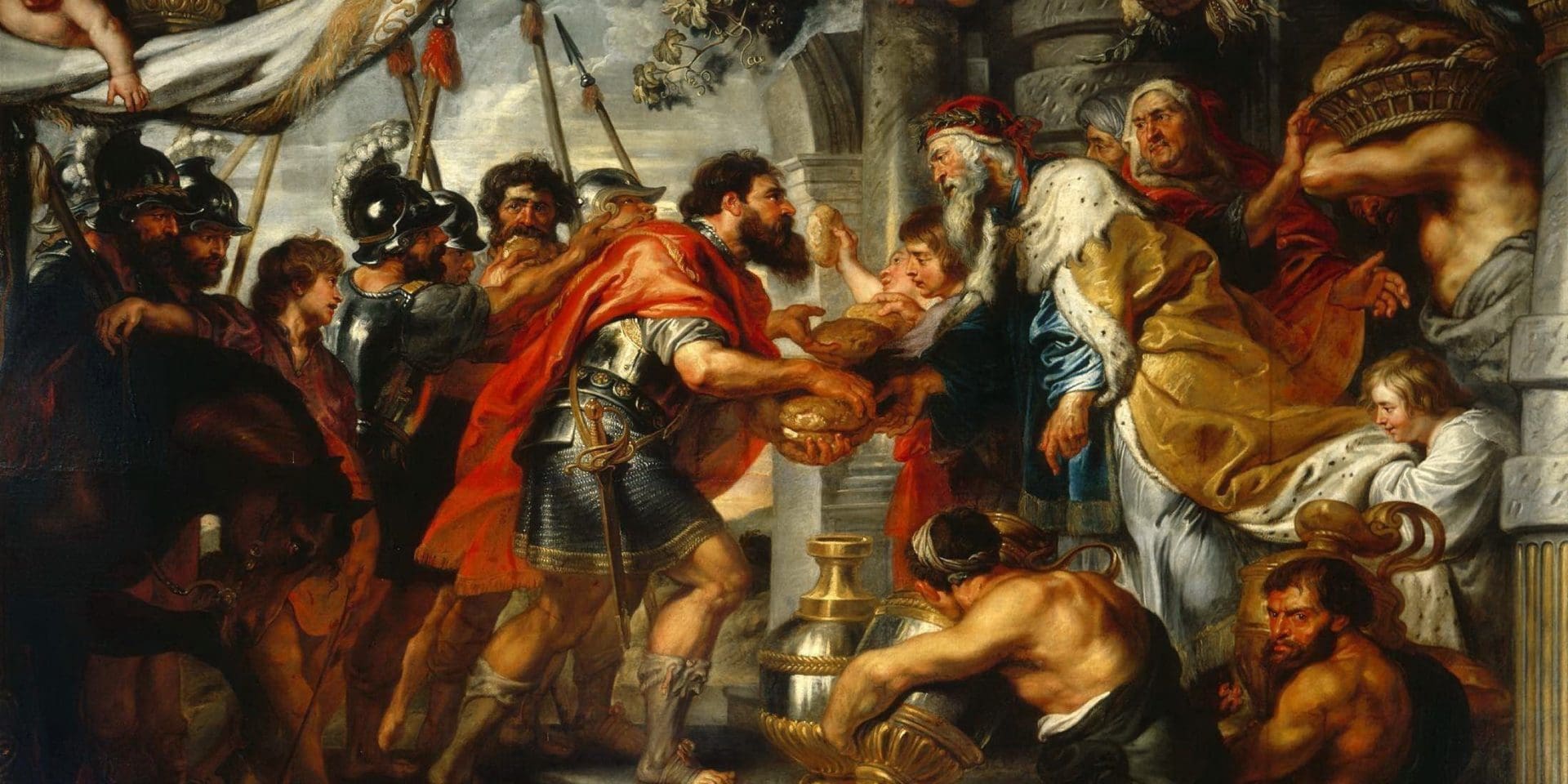When you read the Bible, how often do you try to look at the way the apostles saw the world and use that way of seeing for how you should interpret the Bible? Typology is often scoffed at in contemporary theology and readily undercut by scholars. It is widely regarded as idiosyncratic fluff. Yet it is precisely through the colourful lens of typology that the authors of the Old and New Testaments saw the cosmos.
Typology—a non-verbal prophecy consisting of signs, symbols, rituals, imagery, and allusions that point to a greater spiritual truth—is how God speaks through the visible world[1]. New Testament authors sometimes refer to Old Testament typology as “shadows” of things to come, distinct from the reality it is pointing to (Hebrews 10:1; Colossians 2:16-17). For instance, Peter said that Noah’s Ark is a type of salvation, and that the flood is a type of baptism (1 Peter 3:20-21), and elsewhere we read that the dove is a type of Holy Spirit, as one who brings the guaranteed hope of the new creation to come (Matthew 3:16)[2]; hence why at Christ’s baptism the Holy Spirit descends upon Him like a dove––Christ is the Ark; He is our salvation. These types are all signs that point to something of greater significance than the sign itself.
Now, types are more than just objects or events, they can be people, too. Adam is a type of Christ (1 Corinthians 15:21-22,45), of course, and so is Melchizedek, the priest-king of Salem. And since these types usually point to God, namely Christ, and His redemptive plan of salvation, their meanings tend to unify in a very intricate and multifaceted way.
Consider Holy Communion, which unifies two feasts into one typological whole under Christ: the Passover lamb is a type of Christ insofar that the blood of the lamb guarantees that death will pass over one’s household (Exodus 12:1-11; 1 Corinthians 5:7), and unified with that festival is Melchizedek’s holy supper of bread and wine in Genesis 14 after Abram defeated his enemies in battle and saved his nephew Lot. Harmonized, these types convey our covenantal vocation: having been saved from death by the blood of the lamb over our house, that is our body and the church body (1 Cor.3:16-17,6:19-20), we now go out into the world wearing the full armour of God and defeat the enemies of darkness in spiritual battle to save those captured by sin (Ephesians 6:10-20; 1 Timothy 4:16), and then we, too, as Abraham’s promised children, partake in the Lord’s Supper with our high priest-king of new Jerusalem in His holy temple, that is the body of Christ.
Other times, typology is quite cryptic, if not, hidden in plain sight, if you can call it that. Consider how the author of Hebrews exegetes Genesis 14-15 in Hebrews 6:13–7:28. I’ll just post a portion of it, here:
For this Melchizedek, king of Salem, priest of the Most High God, met Abraham returning from the slaughter of the kings and blessed him, and to him Abraham apportioned a tenth part of everything. He is first, by translation of his name, king of righteousness, and then he is also king of Salem, that is, king of peace. He is without father or mother or genealogy, having neither beginning of days nor end of life, but resembling the Son of God he continues a priest forever. See how great this man was to whom Abraham the patriarch gave a tenth of the spoils! And those descendants of Levi who receive the priestly office have a commandment in the law to take tithes from the people, that is, from their brothers, though these also are descended from Abraham. But this man who does not have his descent from them received tithes from Abraham and blessed him who had the promises. It is beyond dispute that the inferior is blessed by the superior. In the one case tithes are received by mortal men, but in the other case, by one of whom it is testified that he lives. One might even say that Levi himself, who receives tithes, paid tithes through Abraham, for he was still in the loins of his ancestor when Melchizedek met him.
– Hebrews 7:1-10
There are many things to consider in this passage, but I only want to highlight two.

When Scripture is silent, it speaks volumes.
The overarching point of Hebrews 6:13–7:28 is that Jesus is the guarantor of a better covenant (7:22). Hebrews grounds the reason for Christ’s covenantal authority over the Abrahamic and Mosaic covenants, as well as the Levitical priesthood, in the typological parallels shared by Melchizedek and Jesus Christ[3]. He argues that Melchizedek is a type of Christ, and that Jesus Himself comes in the likeness of Melchizedek (vv.15-16), as one “resembling the Son of God” who is “priest forever” (v.3). The most peculiar yet insightful aspect of this argument is that the typological evidence is not in its positive attributes, in the things described about Melchizedek—say, the meaning of his name and the city he rules, or that Abram was served Communion from a priest of the true God who was also the king of Salem, that is Jerusalem before it was Jerusalem—the author emphasizes the negative aspects, the absence of any written material about Melchizedek’s life.
While Melchizedek’s brief and monumental appearance foreshadows the covenant to come, of God fulfilling His promise to Abraham and his offspring (inheritors of the promise), it is chiefly the absence of any recorded “father or mother or genealogy” (7:3) which is sufficient evidence of typology, that which points to Jesus’ divine eternality and continual priestly vocation as “a high priest forever after the order of Melchizedek” (6:20). The positive typological parallels warranted the negative typological evidence, though unspoken it was. The author seems to make an argument entirely from silence, yet given Scripture’s divine inspiration and atemporal intentions, its silence is not nothing. It is a whisper. His mysterious yet historical interjection into the text is not just playful, it is prophetic.
Don’t simply read between the lines, read behind them.
If we press this point a little further, Melchizedek is not historically a type of Christ, he is a literary type of Christ. In physical the world, Melchizedek does indeed have a mother and father and genealogy, but it is not recorded in Scripture. And because of this fact, the author argues that this hereditary silence is typological of Jesus’ eternal priesthood. Therefore, Melchizedek is not literally without parents, he is literarily without parents, just as Jesus is not literally without parents or genealogy, either, but is fully God, an uncreated and pre-existent eternal Being, and fully man with a biological mother and adopted father (Luke 3:4-7,23-38). What Scripture keeps in and what it leaves out is deliberately set apart for a special purpose.
How can it be that the author finds licence to make an argument with ‘figurative’ evidence from a historical narrative if the typology itself is not concrete, objective, or historically true? It tells you something about the nature of Scripture—its literary uniqueness is divinely intentional for spiritual ends—insofar that typology is interwoven in-and-out of the text as a way of obtaining (spiritual) truth. The text is not always articulating 1:1 physical correspondence with history or science. It is a redemptive historical book uniquely and prophetically curated to understand the character and purposes of God to edify the soul, which is precisely how the author finds warrant in referencing the absence of Melchizedek’s recorded parentage as evidence of Christ’s divine authority. You would not do this with a normal book. Scripture is something other. It looks beyond the immediate material laid in front of you to paint a prophetic picture and typological metanarrative.
In Summary
Scripture was written for salvation and the edification of the soul, which is understood through prophecies and typologies anchored in Christ. Ancient man saw the world very differently, and read Scripture very differently, and interpreted evidence very differently. Scripture is fundamentally something other than normal written work. The spirit of prophecy moves in and through, between and behind, every jot and tittle. Typology, then, is a way to see behind the curtain of Scripture. Prophecy, and thus typology, is not just predictive—though it clearly is that—it is divine insight into the immediate context, situation, and hearts of men. It is spiritual wisdom and knowledge that would not be otherwise: “For the testimony of Jesus is the spirit of prophecy.” (Revelation 19:10). Reasoning in a typological way unveils that apostolic nous, the way that Scripture sees the world.
But what pastor, scholar, or theologian do you know today who would consider this kind of reasoning legitimate or vital for Biblical interpretation?
I suppose we all have blind spots, but this one seems pretty big.

Matlock Bobechko is the Chief Operating/Creative Officer of Bible Discovery. He is an eclectic Christian thinker and writer, award-winning screenwriter and short filmmaker. He writes a blog on theology, apologetics, and philosophy called Meet Me at the Oak. He is also an Elder at his local church.
[1] Typologies can appear in a variety of forms such as dreams, visions, festivals, poetry, and historical narrative.
[2] That the dove brings an olive branch, which is used for anointing oil to sanctify priests, as a type of guaranteed promise that the new creation (or the Promised land) is near only intensifies Paul’s claim that the Holy Spirit is a guarantee of our salvation (2 Corinthians 1:22, 5:5; Ephesians 1:14).
[3] The author also shows that Melchizedek received tithes from Abram in Genesis 14 before Abram received the promise and covenant of circumcision from God in Genesis 15, which means that Levi also honoured and paid tithes through Abraham for it is “beyond dispute that the inferior is blessed by the superior” (7:7). The Abrahamic and Mosaic covenants paid tribute to Melchizedek, which renders the order of Melchizedek greater than the Levitical priesthood. Christ did not come in the order of Aaron, he came in the order of Melchizedek: “Now if perfection had been attainable through the Levitical priesthood (for under it the people received the law), what further need would there have been for another priest to arise after the order of Melchizedek, rather than one named after the order of Aaron? For when there is a change in the priesthood, there is necessarily a change in the law as well.” (7:11-12)






